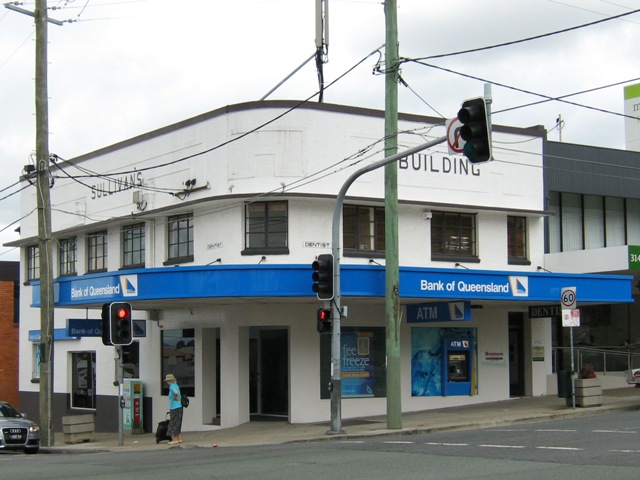Addresses
Type of place
Shop/s
Period
Postwar 1945-1960
Style
Functionalist
Addresses
Type of place
Shop/s
Period
Postwar 1945-1960
Style
Functionalist
The Sullivan’s Building is situated on the prominent north-eastern corner of Cavendish and Old Cleveland Road and as a two storey, rendered masonry commercial building it has significant landmark qualities and as such is important to the Coorparoo area. Built in 1952 by James Sullivan, the Sullivan’s building is a rare example of early 1950s Functionalist architecture.
Lot plan
L1_RP12727
Key dates
Local Heritage Place Since —
Date of Citation —
Construction
Walls: Masonry - RenderCriterion for listing
(A) Historical; (E) AestheticInteractive mapping
Lot plan
L1_RP12727
Key dates
Local Heritage Place Since —
Date of Citation —
Construction
Walls: Masonry - RenderCriterion for listing
(A) Historical; (E) AestheticInteractive mapping
History
The initial settlement of the area now known as Coorparoo was relatively slow. Coorparoo land sales occurred from 1856, gradually development occurred with mainly farmers and land speculators purchasing land at these early sales. By 1888, the locality had a population in excess of 2,000 people in over 550 homes. The population growth in the area saw ribbon development along the main transport arteries of Logan Road and Old Cleveland Road; pocket development in areas such as Stones Corner; with the wealthier residents living on the hill tops especially along the Cavendish Road ridgeline.
From the mid 1870s the population of Brisbane increased markedly and a rise in residential settlement began to occur. Brisbane’s population had grown to 47, 000 by 1881. It was during the 1880s that the greatest changes to the residential settlement patterns occurred. This was due to several factors including an expanding economy, expansion of infrastructure including extended tram and train services, improved communication systems, and an increase in immigration to Brisbane. By 1891 Brisbane’s population had increased to over 100, 000.
By the 1890s, the Stones Corner and Coorparoo area included a socio-economic mix that ranged from farmers to politicians. These included Frederick Brentnall M.L.C., James Stodart M.L.A. and Walter Henry Barnes M.L.A., business men such as Nathaniel Lade, James Hipwood and Reuben Nicklin and important public servants such as Edward Deshon C.M.G., Reginald Mulholland King, James Evan Burstall and T.W. Connah. Coorparoo, while not distant from the city, was a semi-rural area until the 1910s. Then the population began to increase rapidly due to the extension of the tramline to Stones Corner in 1915.
One of the important Coorparoo roads became Cavendish Road with its plethora of hilltops. This road developed into an elite address for a small number of wealthy local residents. By the 1890s, there were six such families living along Cavendish Road between Old Cleveland and Chatsworth Roads and in 1914 this number had increased to ten. They built their large houses on acreage sites, employed domestic staff and had such amenities as kitchen gardens, orchards, fowl houses and tennis courts.
The interwar period heralded a period both of residential expansion and developmental consolidation in Brisbane. With the extension of tramlines, suburbs such as Greenslopes, Camp Hill and Coorparoo experienced major increases in residential development throughout the 1920s and 1930s.
Immediately after the Second World War, Australia experienced a severe building material shortage. With this came tight governmental controls on building sizes and styles. These restrictions were not lifted until 1952. Significantly the Sullivan’s Building was constructed during this period and is important as an example of the post-war commercial development that occurred in the Coorparoo area.
Prior to 1952 James Anthony Sullivan owned a butchers shop at 334 Old Cleveland Road, Coorparoo. In 1952 Sullivan built the two storey rendered masonry building as an investment property. It was originally designed to accommodate a dental clinic on the first floor and retail premises on the ground floor.
Only eight years after the Sullivan’s Building was constructed the Coorparoo Myer building was opened on the opposite corner of Cavendish and Old Cleveland Road to Sullivan’s, thus establishing this part of Coorparoo as a retail and commercial centre.
Description
The Sullivans Building is a two storey rendered masonry structure in the Inter-War Functionalist style. The building's roof is concealed by a parapet with simple geometric motifs and the words "Sullivan's Building" in raised block lettering. The rounded corner of the building is repeated in the horizontal cantelevered hood above the band of upper floor windows. The cantelevered footpath awning also has a round corner addressing the intersection. The upper floor casement windows appear to be original, and the original "dentist" signs are located above the footpath awning. The lower floor facade contains recent aluminium shopfront glazing.
Statement of significance
Relevant assessment criteria
This is a place of local heritage significance and meets one or more of the local heritage criteria under the Heritage planning scheme policy of the Brisbane City Plan 2014. It is significant because:
References
-
Historic Titles, Department of Natural Resources and Water
-
Queensland Post Office Directories
-
Metropolitan Water and Sewage Survey Maps, 1949
-
Coorparoo, Stones Corner Centenary, 1856 – 1956, Printed by The Courier Mail, 1956
Citation prepared by — Brisbane City Council (page revised September 2020)

